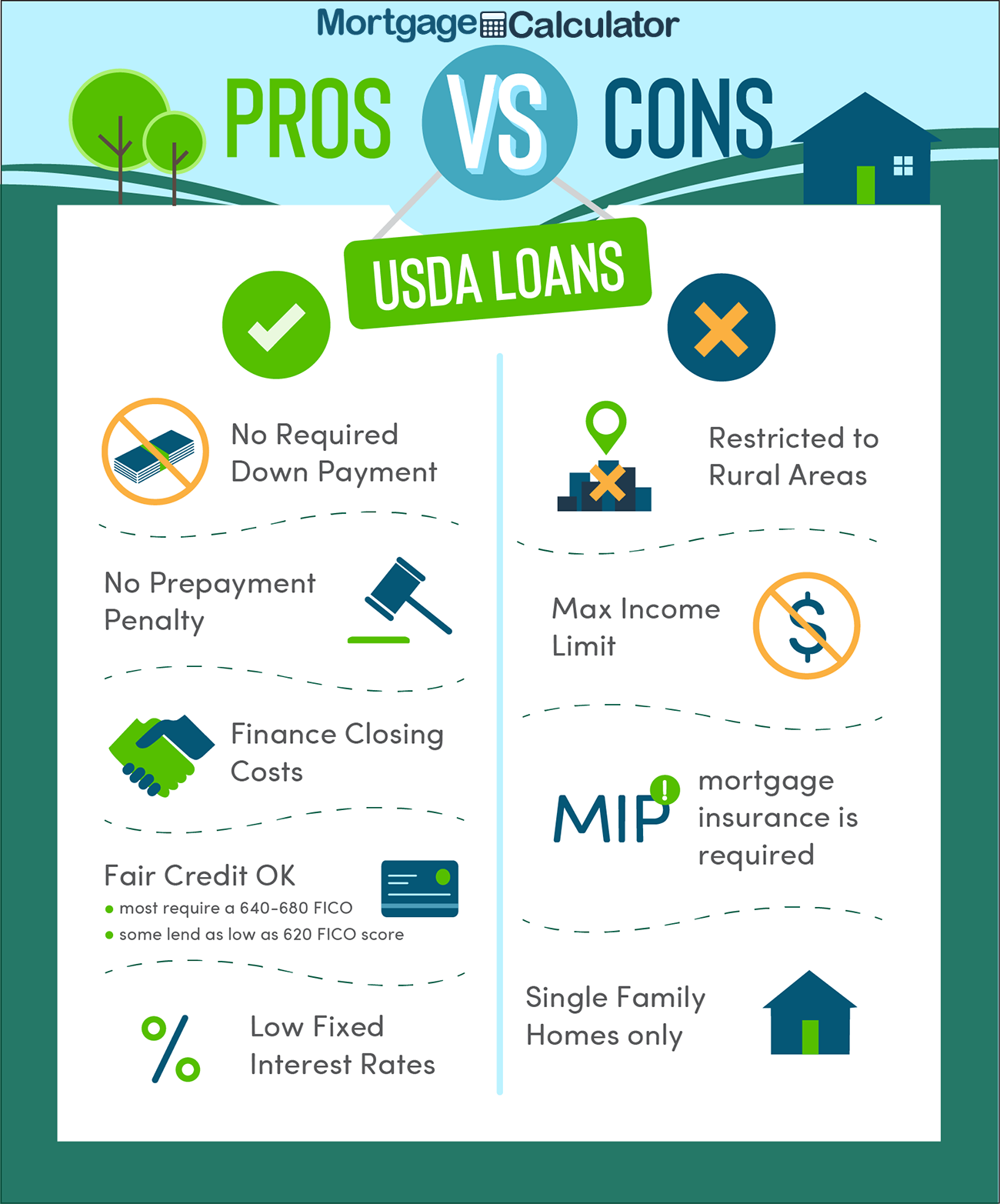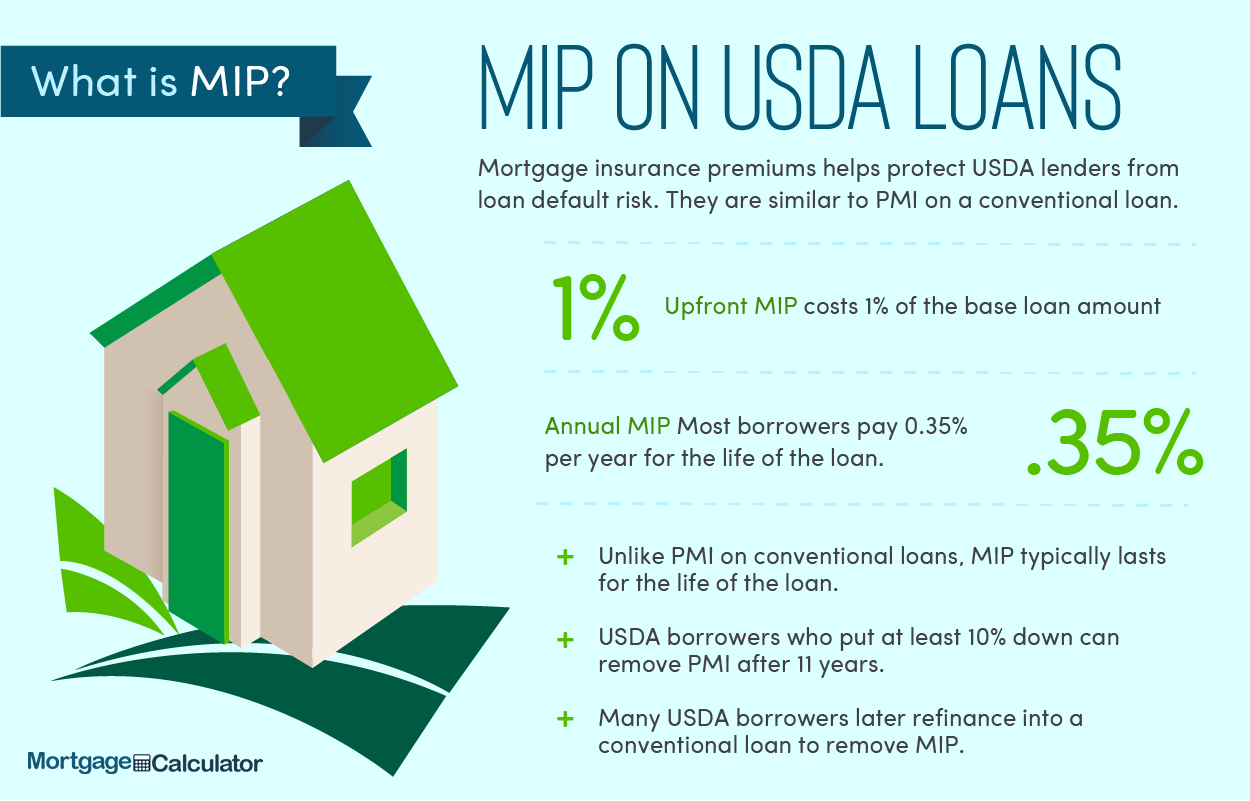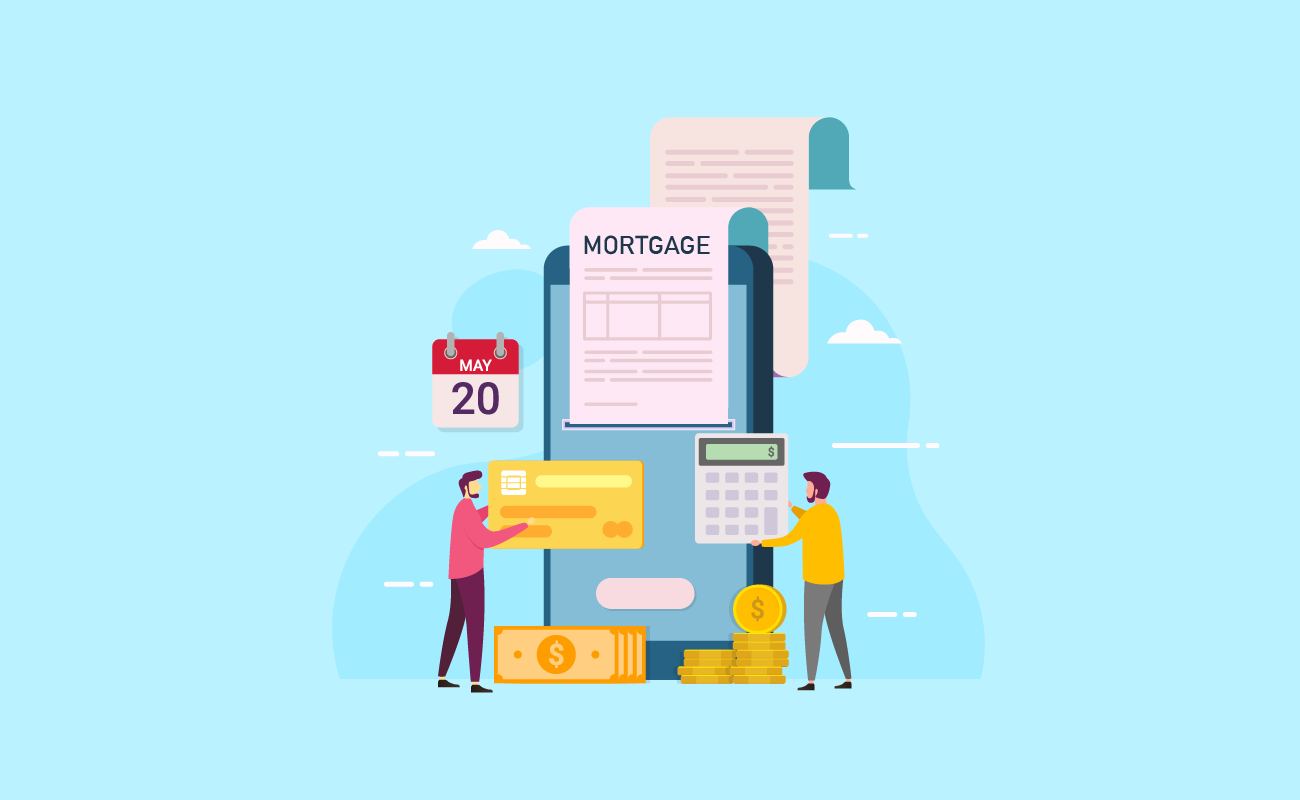
Use this free calculator to figure your monthly USDA home loan payments inclusive of mortgage insurance premium (MIP), loan guarantee fees, and other common homeowner related expenses including property taxes and insurance. Once you are done with your calculation at the bottom of the calculator there is a button to create a printable amortization schedule.
This calculator figures monthly home payments for USDA loans. To help you see current market conditions and find a local lender current mortgage rates are published in a table below the calculator.
Here is a table listing current mortgage rates.
The following table shows current 30-year mortgage rates available in . You can use the menus to select other loan durations, alter the loan amount, or change your location.
USDA guaranteed loans help fund rural development across the country.
In addition to the following brief overview, we also publish a more in-depth guide to USDA loans which highlights their range of loan and grant programs. The following briefly covers the section 502 loan guarantee program.

Visit USDALoans.com today to prequalify.
USDA guaranteed loans help fund rural development across the country. And as home prices continue to increase in major cities, families make the choice to live in the suburbs or rural areas.
In addition to the following overview, we also published a more in-depth guide to USDA loans which highlights their range of loan and grant programs. The following article covers section 502 of the USDA Guaranteed Loan Program.

A USDA guaranteed loan is a type of mortgage backed by the U.S. Department of Agriculture. This program is specifically designed for low to moderate income homebuyers who are looking to live in rural or suburban locations. It was created to boost rural development by extending credit to qualified homebuyers. Borrowers can purchase, rebuild, improve, or relocate a dwelling in any approved USDA rural area. The USDA guaranteed loan is also referred to as the Section 502 loan, which is based on section 502(h) of the 1949 Housing Act.
USDA loans are an affordable mortgage option that it come with low interest rates compared to common conventional loans. The guarantee secures USDA-sponsored lenders, allowing them to offer much lower rates. It also provides 100% financing, which means eligible borrowers are not required to make a down payment. And unlike conventional mortgages, has more lenient credit score standards. On the other hand, it requires mortgage insurance premium (MIP) which is called a guarantee fee. USDA loan come with reduced mortgage insurance, which is lower than other types government-back loans. MIP is an additional cost that protects lenders in case you default on your mortgage.
USDA guaranteed loans are available as 30-year fixed-rate loans and cannot be taken as an adjustable-rate mortgage. It is only granted for single family homes and cannot be taken for vacation homes or rental properties. Your property may have a barn or silo, but it should not be used for commercial purposes. A condominium unit can be approved for a USDA loan, as long as its located in a USDA rural area.
Moreover, USDA loans do not impose prepayment penalty fees, allowing you to pay your mortgage early without worrying about added costs. For borrowers with an existing mortgage, there are USDA refinancing programs that allow you obtain more favorable rates and terms. This can help make your monthly payments more manageable. But if you need to borrow against your home equity, note that USDA loans do not provide a cash-out option for refinances.
If you’re struggling with reduced income but have a good credit history, consider taking a USDA guaranteed loan. Having a good credit history makes you an ideal candidate. You may still qualify for a USDA loan even if a low income makes you ineligible for a conventional mortgage. USDA loans are offered by banks, credit unions, and mortgage companies.
USDA Loans & the COVID-19 Pandemic With the onset of the COVID-19 pandemic in early 2020, unemployment rates rose as high as 14.7% in April, according to the Bureau of Labor Statistics. Many households struggled to make mortgage payments between April to July 2020. Likewise, a considerable number of homebuyers put their purchases on hold until they could find stable employment. Despite these circumstances, the USDA reported June 2020 applications rose by over 53% compared to the previous year.
The USDA program prioritizes applicants that meet qualifying standards such as income eligibility, area requirements, credit score, and debt-to-income ratio, among others. The conforming loan limit for conventional mortgages across the United States is $806,500 in 2025. This maximum loan limit applies to conventional mortgages, but does not apply to USDA home loans. Instead the USDA home loan limit is determined by a combination of personal, local, and nationwide factors.
You must satisfy the following requirements to be eligible for a USDA guaranteed loan.
As a main requirement, you can only select homes in qualified USDA rural areas. The USDA generally defines rural areas as towns, communities, or small cities occupied by less than 20,000 people. But in other instances, they may approve locations with up to 35,000 residents. These places should not be located in a metropolitan statistical area (MSA) and must lack mortgage credit for low to average income households. Urban areas, meanwhile, are usually defined as places with a population of 50,000 or more.
In 2015, the USDA announced updated guidelines for what they consider as rural areas. This update made it more challenging to get approved for a USDA loan, especially since populations have grown substantially since the prior categorization. Prior to 2015, over 90% of property in the U.S. qualified for USDA financing.
Though these guidelines may seem too restrictive, extended parts of metro areas in small cities and towns may be eligible. To verify if your area qualifies for a USDA loan, you can check interactive maps on the USDA website. You simply type in the address and it will indicate if the location is eligible or not.

To obtain a USDA loan, you must fall under the required income limit for moderate income. Moderate income is defined as the greater of
Limits are based on both the local market conditions and the size of a family. Household income is calculated by adding the loan applicant’s income plus the income of other family members in a home. This rule applies even if the household member does not share the same family name.
The moderate income guarantee loan limit is the same in any given area for households of 1 to 4 people, and is set to another level for homes of 5 to 8 people. The following table lists examples of limits from a few select areas in the country:
| Location | 1 to 4 Person Limit | 5 to 8 Person Limit |
|---|---|---|
| Fort Smith, AR-OK MSA | $112,450 | $148,450 |
| Northwest Arctic Borough, AK - with a road system (115%) | $133,950 | $176,850 |
| Northwest Arctic Borough, AK - without a road system (150%) | $196,650 | $259,600 |
| Oakland-Fremont, CA HUD Metro | $173,650 | $229,250 |
| San Francisco, CA HUD Metro | $238,200 | $314,450 |
The floor values on the above limits are $112,450 and $148,450, respectively. Homes with more than 8 people in them can add 8% for each additional member. You can verify income limits in your local area by checking the USDA income limits page, or you can use the eligibility checker to enter your personal details.
For example, let’s say the income limit in your area for a 1-4 person household is $112,450 per year. That means you can qualify for a USDA loan with an annual income of $112,450 or less. 15% of $97,780 is equivalent to $14,670, which we added to $97,780 to obtain the $112,450 income limit.
What if I can pay 20% down? Generally, if you can afford to make a 20% down payment on top of your mortgage, you won’t qualify for a USDA loan. If you have assets that exceed the imposed income limits, you likely won’t be approved. But in some cases, a USDA-sponsored lender may approve your loan and require you to make a down payment.
Loan Amount Limits Loans can be used for regular, manufactured, or modular homes which are no more than 2,000 square feet in size. As of eary 2025 the effective loan limit starts at $398,600 in low-cost areas and goes as high as $919,800 in expensive (or high-cost areas) in states like California. New limits came into effect on 3-8-2024, so one should expect a similar increase published in early 2025. You can view loan amount limits in your local area here.
As for credit requirements, USDA lenders prefer a FICO credit score of 640. This is the minimum credit score required to qualify for the USDA’s automated writing system. Homebuyers who satisfy this requirement receive streamlined processing of their application. Meanwhile, borrowers with credit scores below 640 (some lend as low as 620) must submit to a manual underwriting process. If you have further credit issues on your record, your application will take longer to approve.
Conventional loan lenders, on the other hand, usually prefer borrowers with a credit score of 680 and above. If you have limited income and an average credit score, consider taking a USDA loan. Again, homebuyers who cannot qualify for a traditional conventional mortgage may be eligible for a USDA home financing.
Improve Your Credit Score Before applying for any loan, make sure to check your credit report. Borrowers can request for a free copy at AnnualCreditReport.com. Avoiding late payments and reducing your outstanding debts helps improve your credit score. In the long run, having a good credit profile will help you obtain more favorable loan deals in the future.
Like other types of mortgages, borrowers must also meet the required debt-to-income ratio (DTI) to obtain a USDA loan. DTI is a risk indicator which measures the sum of your total monthly debts compared to your gross monthly income.
A low DTI ratio shows you have a good balance of income and debt. This lowers default risk for lenders, which increases your chances of loan approval. On the other hand, a high DTI ratio indicates you cannot take on further debt. DTI requirements for USDA loans are quite similar to conventional mortgages. For conventional loans, the front end-DTI limit is 28%, while the back-end DTI is 43%, but this can be as high as 50% if you have compensating factors.
On regular conventional conforming mortgages, private banks offer funding and typically prefer borrowers that pay 20% down payment of the home’s value. This minimizes the risk of loss to the lender in case a foreclosure takes place. If the borrower pays less than 20% down, they are required to pay private mortgage insurance (PMI). Once the loan balance to home value (LTV) falls below 80%, PMI is automatically cancelled.
On the other hand, USDA loans do not require a down payment, but they are associated with mortgage insurance premium (MIP), which come in two important fees. One is an upfront USDA guarantee fee, and the other is an annual fee which functions similarly to PMI. The upfront fee can be rolled into the loan.
Periodically the fees associated with a USDA loan change to reflect the costs of running the program. The last major change was announced on September 1, 2016, when the upfront guarantee fee dropped from 2.75% to 1%, and the annual fee was lowered from 0.5% to 0.35%. Both the upfront funding fee and the annual insurance premium are far cheaper on USDA loans than the equivalent FHA loan fees.

The following table highlights the cost of these fees on a $250,000 home:
| Fee Type | Upfront Fee | Annual Fee |
|---|---|---|
| Rate | 1.0% | 0.35% |
| Upfront Amount | $2,500 rolled into loan | $0 |
| Annual Amount | $0 | $875.00 |
| Equivalent Monthly Amount | $0 | $72.92 |
As the principal balance is reduced, the associated monthly amount declines.
For example, for a $250,000 loan, your upfront guarantee fee will cost $2,500. If your principal decreases to $230,000, your annual guarantee fee will cost $805, which is $67.84 per month. As your principal balance is reduced, your annual guarantee fee also decreases. The annual guarantee fee is required for the entire life of the loan.
To summarize the difference between USDA loans and conventional loans, we made the table below:
| Qualifications | USDA Loans | Conventional Loans |
|---|---|---|
| Required Area | Must be a USDA rural area | Choose a home location anywhere |
| Income Limit | Your household income cannot exceed 115% of the median income in your area | Does not impose income limits |
| Credit Score | Should be at least 640 Some accept as low as 620 | 680 & up is usually approved 700 & up is ideal |
| Rates | Comes with lower rates because of federal funding | You can obtain a lower rate with a higher credit score Making a high down payment helps decrease your rate |
| Down Payment | Not required Offers 100% financing | 20% eliminates PMI 10% is the average down payment 3% required minimum for a 97-3 loan |
| Front-end DTI | Should not go over 29% | Should not go over 28% |
| Back-end DTI | Should not go over 41% | Usually does not go over 43% With compensating factors, can be up to 50% |
| Cost | 1% upfront guarantee fee 0.35% annual guarantee fee Does not require prepayment penalty | PMI costs in 0.5%-1% of the loan amount annually PMI is cancelled when mortgage balance is below 80% May require prepayment penalty |
Besides the benefits, consider the disadvantages of choosing a USDA loan. Since you can only finance a house in a USDA rural area, this option may not suite you. If you work in the city, living too far out may not be a practical choice. Commuting to work daily takes a lot time, money, and energy that you might not have.
Next, income limits may keep you from qualifying for this type of mortgage. If your household earns more than 115% of the median income in your area, you won’t be approved. You should also think of the annual guarantee fee, which is an extra cost you must budget into your mortgage payments.
USDA loans only apply to single family homes. It should also be a primary home, which means you cannot finance an investment property if you’re planning to rent out a house. These loans also follow minimum property standards to ensure the home is livable and safe. If you intend to purchase a house that requires a lot of renovation, a strict appraiser might not readily approve your home.
Before you choose a USDA loan, check if any of these factors might not align with your priorities and needs.

Like other mortgages, you must submit to credit checks and provide financial documents when you apply for a USDA loan. Be ready to show proof of stable income in the past 24 months. You must submit information about your gross monthly income, total monthly debts, and your assets.
USDA-sponsored lenders screen for a clean credit history. This means your records should not have accounts converted to collections in the last 12 months. But in case of emergencies, if you can prove you were affected by a temporary event outside of your control (such as accidents), you can still obtain a USDA loan.
Make sure to gather the following documents for your application:

USDA guaranteed loans are only available as 30-year fixed-rate mortgages. The long payment term makes monthly payments more affordable for borrowers. And with no down payment required, this sounds convenient for moderate-income homebuyers. However, you must understand that making a small down payment is worth increasing your savings.
Using our calculator on top, let’s estimate mortgage payments with the following example. Let’s say you took a 30-year fixed USDA loan worth $250,000 at 3% APR. The following table compares the cost of making no down payment, a 3% down, and a 5% down on your loan.
| Mortgage Details | No Down Payment | 3% Down ($7,500) | 5% Down ($12,500) |
|---|---|---|---|
| Amount Borrowed | $250,000 | $242,500 | $237,500 |
| Upfront Guarantee Fee | $2,500 | $2,425 | $2,375 |
| Monthly Principal & Interest Payment | $1,054.01 | $1,022.39 | $1,001.31 |
| Monthly Taxes, Insurance, & MIP | $381.25 | $379.06 | $377.60 |
| Total Monthly Mortgage Payment | $1,435.26 | $1,401.45 | $1,378.91 |
| Total Interest Costs | $129,444 | $125,560 | $122,971 |
The results show making a small down payment lowers the amount you borrowed. This immediately decreases your upfront guaranteed fee, which is 1% of your loan amount. If you don’t make a down payment, your upfront guarantee fee will cost $2,500. But with 3% down, it’s reduced to $2,425, while a 5% down lowers the upfront guarantee fee to $2,375.
Next, the lower loan amount reduces your total monthly payments. Based on the table, the highest total monthly payment is $1,435.26 when you don’t make a down payment. But with 3% down, your monthly payment decreases to $1,401.45, while a 5% down lowers it to $1,378.91. Paying 3% down saves you $33.81 per month, and a 5% down saves you $56.35 per month.
Savings are most evident when we compare the total interest costs. With no down payment, your total interest will amount to $129,444. But if you pay 3% down, your interest charges will decrease to $125,560, while a 5% down will reduce your total interest costs to $122,971. A 3% down will save you $3,884 on total interest charges, while a 5% down will save you $6,473. The higher your down payment, the more you’ll save on interest costs.
This example shows that making a small down payment will help decrease your mortgage payments. Overall, it significantly reduces your total interest charges over the life of the loan. Even with a zero-down option, it makes better sense to save a small down payment for a USDA loan. Thus, it’s best to save a little down payment before you take this mortgage option.
Homebuyers looking to live away from the city can take advantage of USDA loans. This provides affordable financing for low to average income borrowers, which comes with low rates and a zero down payment option. It also has more lenient credit requirements compared to conventional loans. USDA loans are a good fit for borrowers who have low income, but otherwise have a decent credit rating.
On the other hand, because it’s strictly limited to USDA rural areas, finding the right location may be challenging. It may not be an option especially if you have a stable job in the city. USDA loans also cannot be used for vacation homes or investment property that generates income.
Moreover, you must satisfy income limits to qualify. If your income does not fall within 115% of the median family income in your area, your loan will not be approved. USDA loans also require MIP in the form of an upfront guarantee fee and an annual guarantee fee. The annual guarantee fee is an added cost that’s usually required for the entire life of the loan. But as your loan amount decreases, so does your guarantee fee.
Finally, despite the zero down option, consider making a small down payment. Making a down payment on a USDA mortgage helps reduce your loan amount, which also decreases your monthly payment. In the long run, this will save you thousands of dollars on interest charges compared to not making a down payment at all.
US 10-year Treasury rates have recently fallen to all-time record lows due to the spread of coronavirus driving a risk off sentiment, with other financial rates falling in tandem. Homeowners who buy or refinance at today's low rates may benefit from recent rate volatility.
Don't pay too much for your mortgage. Leverage our lender network to get a USDA loan at today's historically low mortgage rates.
Check your mortgage options with a trusted lender.
Answer a few questions below and connect with a lender who can help you lock-in a low rate USDA loan and save today!